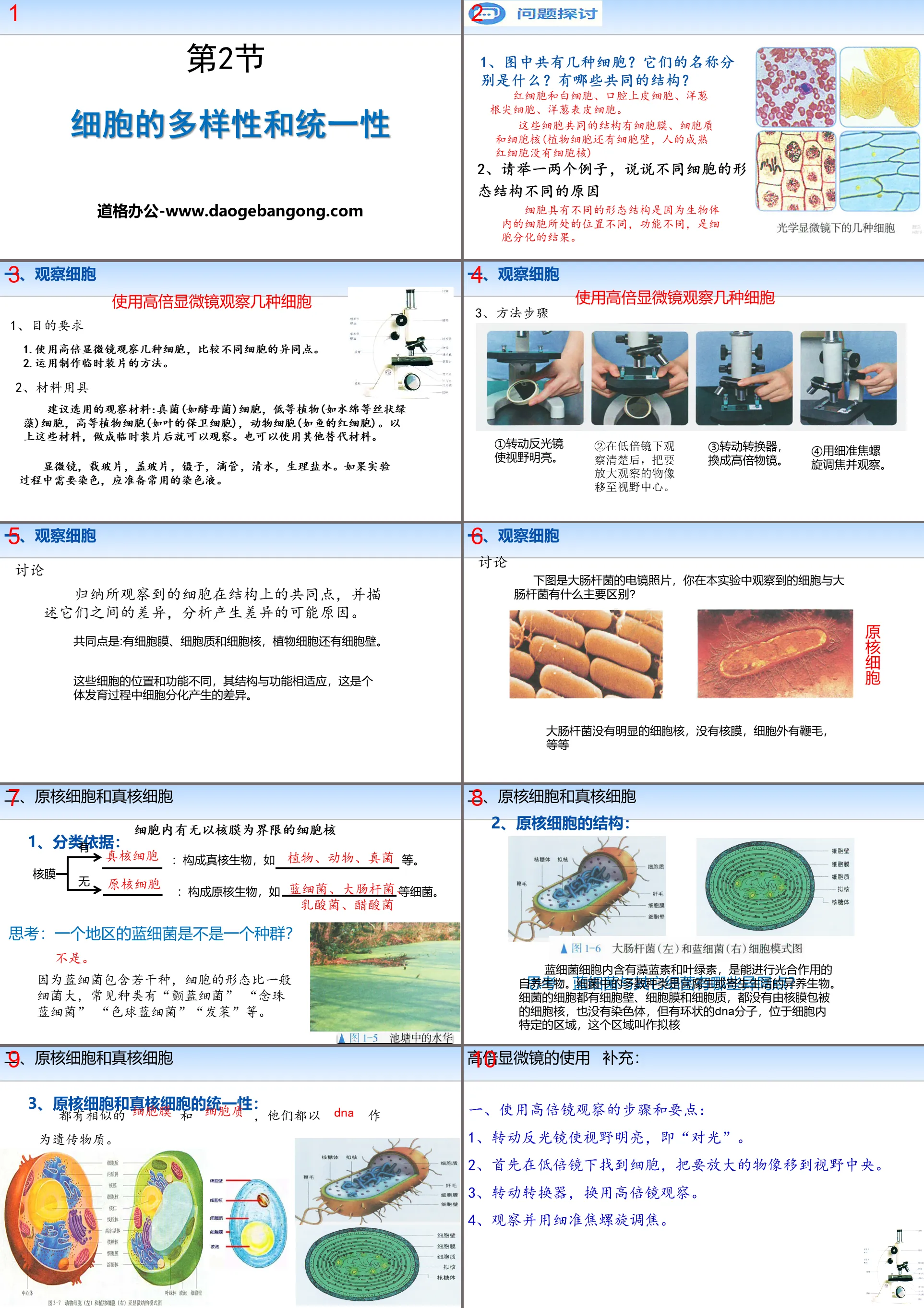
| Category | Format | Size |
|---|---|---|
| High School Biology Compulsory Course 1, published by People's Education Press | pptx | 6 MB |
Description
"Diversity and Unity of Cells" Approaching Cells PPT Download
Part One: Problem Exploration
1. How many cells are there in the picture? What are their names? What are the common structures?
Red blood cells and white blood cells, oral epithelial cells, onion root tip cells, onion epidermal cells.
The common structures of these cells include cell membrane, cytoplasm and nucleus (plant cells also have cell walls, and mature human red blood cells do not have a nucleus)
2. Please give one or two examples to explain why different cells have different morphological structures.
Cells have different morphological structures because cells in the organism are in different locations and have different functions, which are the result of cell differentiation.
Diversity and Unity of Cells PPT, Part 2: 1. Observing Cells
Observe several types of cells using a high-power microscope
1. Purpose requirements
1. Use a high-power microscope to observe several types of cells and compare the similarities and differences of different cells. 2. Use the method of making temporary mounting films.
2. Materials and tools
Suggested observation materials: fungal (such as yeast) cells, lower plant cells (such as Spirogyra and other filamentous green algae) cells, higher plant cells (such as guard cells of leaves), animal cells (such as fish red blood cells). The above materials can be observed after being made into temporary mounts. Other alternative materials may also be used.
Microscope, slides, coverslips, tweezers, dropper, water, saline. If staining is required during the experiment, commonly used staining solutions should be prepared.
3. Method steps
① Turn the reflector to brighten the field of view.
②After observing clearly under low magnification, move the object image to be magnified and observed to the center of the field of view.
③ Turn the converter to turn into a high-magnification objective lens.
④ Use the fine focus screw to adjust the focus and observe.
discuss
Summarize the common structural features of the observed cells, describe the differences between them, and analyze the possible reasons for the differences.
What they have in common is that they have a cell membrane, cytoplasm and nucleus, and plant cells also have a cell wall.
The positions and functions of these cells are different, and their structure and function are adapted. This is a difference caused by cell differentiation during ontogeny.
Diversity and Unity of Cells PPT, Part 3: 2. Prokaryotic Cells and Eukaryotic Cells
Is there a nucleus bounded by the nuclear membrane in the cell?
1. Classification basis:
Thinking: Are the cyanobacteria in an area a population?
no.
Because there are several species of cyanobacteria, the cell shape is larger than that of ordinary bacteria. Common species include "Cyanobacteria", "Cyanobacteria moniliforme", "Chromococcus cyanobacteria", "Nostoc", etc.
2. Structure of prokaryotic cells:
Cyanobacteria contain phycocyanin and chlorophyll in their cells and are autotrophs capable of photosynthesis. Most species of bacteria are saprotrophic or heterotrophic organisms that live a parasitic life. Bacterial cells have a cell wall, cell membrane, and cytoplasm. They do not have a nucleus surrounded by a nuclear membrane, nor do they have chromosomes. Instead, they have circular DNA molecules located in a specific area within the cell. This area is called a nucleoid.
3. The unity of prokaryotic cells and eukaryotic cells:
They all have similar _______ and _______, and they all use _______ as their genetic material.
Use of high-power microscopes Supplement:
1. Steps and key points for using high-magnification microscope observation:
1. Turn the reflector to brighten the field of vision, that is, "aiming the light".
2. First find the cells under low magnification and move the object to be magnified to the center of the field of view.
3. Turn the converter and use a high-magnification lens for observation.
4. Observe and adjust the focus using the fine focusing screw.
Diversity and Unity of Cells PPT, Part 4: Classroom Exercises
Combined with Figure 1-6 of the textbook P11, Escherichia coli and cyanobacteria cell model diagrams, solve the following problems.
1. What is the biggest structural difference between A, B, and C? What structures do they share?
Answer: A and B are prokaryotic cells, and C is a eukaryotic cell. The biggest structural difference between A, B, and C is that A and B do not have a nucleus surrounded by a nuclear membrane; they all have cell membranes, cytoplasm, ribosomes, etc. structure.
2. Fill in the names of the relevant structures in Figures A and B.
Answer: ① cell wall, ② cell membrane, ③ cytoplasm, ④ nucleoid, ⑤ ribosome.
Diversity and Unity of Cells PPT, Part 5 Content: Written Assignment:
short answer questions
1. Write down the main steps for using a high-power microscope.
2. Textbook P11: "Contact with Society": What is the essential difference in biological classification between "lettuce" and the "lettuce" we usually eat?
3. Textbook P11 Cyanobacteria are autotrophs, and most bacteria are heterotrophs. So what is the essential difference between autotrophs and heterotrophs?
4. Textbook P12, Question 2 of Extended Application.
Keywords: Free download of the PPT courseware for High School Biology Compulsory Course 1 from the People's Education Press, PPT download of the diversity and unity of cells, PPT download of Approaching Cells, .PPT format;
For more information about the "Approaching Cells Diversity and Unity of Cells" PPT courseware, please click the "Approaching Cells ppt Diversity and Unity of Cells ppt" tag.
"Diversity and Unity of Cells" Approaching Cells PPT Courseware:
"Diversity and Unity of Cells" Approaching Cells PPT courseware Part One: Pre-class independent preview plan 1. Observing cells 1. Observe cells using a high-power microscope 2. Microstructure and submicroscopic structure (1) Microstructure: Cell structures observed under _________..
"Diversity and Unity of Cells" Approaching Cells PPT:
"Diversity and Unity of Cells" Approaching Cells PPT Part One: Laying the Foundation for Necessary Knowledge Literacy 1. Using a high-power microscope to observe cells 1. Basic steps for using a microscope: Take the lens, place it, light it, press it, focus it and observe it. 2. Four-character tips for using high-magnification lenses: 3. Display...
"Cell is the basic unit of life activity" Approaching Cell PPT courseware download:
"Cell is the basic unit of life activity" Approaching Cells PPT courseware download Part One: New Lesson Introduction On January 27, 2017, the world's first somatic cell cloned monkey was born in my country. It is a major breakthrough achieved by Chinese scientists after five years of research. Got a lot of genetics..
File Info
Update Time: 2024-07-12
This template belongs to biology courseware High School Biology Compulsory Course 1, published by People's Education Press industry PPT template
"Diversity and Unity of Cells" Approaching Cells PPT Download Simple campus recruitment activity planning plan summary enterprise and institution recruitment publicity lecture PPT template is a general PPT template for business post competition provided by the manuscript PPT, simple campus recruitment activity planning plan summary enterprise and institution recruitment promotion Lecture PPT template, you can edit and modify the text and pictures in the source file by downloading the source file. If you want more exquisite business PPT templates, you can come to grid resource. Doug resource PPT, massive PPT template slide material download, we only make high-quality PPT templates!
Tips: If you open the template and feel that it is not suitable for all your needs, you can search for related content "Diversity and Unity of Cells" Approaching Cells PPT Download is enough.
How to use the Windows system template
Directly decompress the file and use it with office or wps
How to use the Mac system template
Directly decompress the file and use it Office or wps can be used
Related reading
For more detailed PPT-related tutorials and font tutorials, you can view: Click to see
How to create a high-quality technological sense PPT? 4 ways to share the bottom of the box
Notice
Do not download in WeChat, Zhihu, QQ, built-in browsers, please use mobile browsers to download! If you are a mobile phone user, please download it on your computer!
1. The manuscript PPT is only for study and reference, please delete it 24 hours after downloading.
2. If the resource involves your legitimate rights and interests, delete it immediately.
3. Contact information: service@daogebangong.com
"Diversity and Unity of Cells" Approaching Cells PPT Download, due to usage restrictions, it is only for personal study and reference use. For commercial use, please go to the relevant official website for authorization.
(Personal non-commercial use refers to the use of this font to complete the display of personal works, including but not limited to the design of personal papers, resumes, etc.)
Preview




















